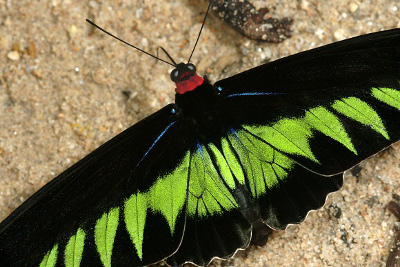Rajah brookes Birdwing Butterfly
Category: Butterfly

Facts about Rajah brooke's Birdwing Butterfly, "Scientific name for Rajah brooke's Birdwing butterfly is Trogonoptera brookiana". The Rajah brooke's Birdwing Butterfly is a black and electric green birdwing butterfly inhabiting mainly the Thai-Malay rainforests. Other rainforests where they can be found are Peninsula, Borneo, Natuna and Sumatra. Rajah brooke's Birdwing butterfly belongs to the group of butterflies in the Papilionidae family known as birdwings due to their characteristic long wings and their bird-like flights. Their resting posture is another indication of their name; it is entirely unlike all other butterflies. The Rajah brooke's Birdwing Butterfly was named after James Brooke, the Rajah of Sarawak in 1855 by Alfred .R. Wallace. It is the national butterfly of Malaysia.
Physical characteristics
Rajah brooke's Birdwing butterfly is similar in looks to the Palawan Birdwing though males have a more greenish color in the rear wings. It’s wingspan extends up to 6 1/2 (17cm). The males have generally black dominating color on their wings with seven teeth shaped electric green marks. A large electric green patch on the hind wings completes the general look of the Rajah Brooke’s Birdwing’s wings. On the contrary, the female species have a browner color on their wings with flashes of white at the tips of its fore-wing. A similar trend in coloring is also prominent at the bases of the hind wings. The male Rajah brooke's Birdwing Butterfly have brighter markings than the females. Their head is bright red while their bodies are black with markings of red all over them. The Rajah brooke's Birdwing Butterfly different looks are an illustration of sexual dimorphism, which means that both males and females look different from one another.
Habitat
The Rajah brooke's Birdwing butterfly live in tropical rainforest habitats of altitudes ranging from sea level to about 875 yards (800 meters) above sea level. The Rajah brooke's Birdwing Butterfly breed at an altitude of 330 yards (300 meters). Mainly, the males are the only butterflies seen as the females spend most of their time on treetops. The rainforests are very dense, relatively warm and wet. This makes them havens for most animals and plants for their suitable climate. Mostly, the male Rajah brooke's Birdwing Butterfly are seen in riverbanks and mud puddles sipping mineral-rich water, which is required for provision of sodium and potassium for activation of their adult behavior. Actually, Rajah brooke's Birdwing Butterfly is the only butterfly to be attracted to water. This species of butterflies are important to long-range pollination for nectar bearing flowers basically in canopy forests. Their strong flights indicate that the Rajah brooke's Birdwing Butterfly can fly for very far distances and high above in search for sunlight.
Reproduction
The eggs, globular reddish, are laid on leaves of climbing vines of the Aristolochia (Aristolochia foveolata). The legs are laid one egg per leaf on the tips of the vines leaves. A fully-grown caterpillar is dark greyish brown with a light grey saddle mark on the back. Buff and grey tubercles cover the whole extent of the body. The larvae of the Rajah brooke's Birdwing Butterfly are voracious eaters but their movement is very slow. Once they defoliate a certain leaf, they move on to the other and sometimes starvation might lead to cannibalism. The caterpillars have an osmeterium behind the head that secretes a pungent fluid, which deters potential predators. The caterpillars are very unappealing and toxic due to their feeding habits. Caterpillars concentrate this aristolochic acid in their tissues up until they attain adulthood.
The pupa is apple green with violet markings. It is attached by the cremaster and silk girdle to the vine stem vertically. "Scientific name for butterfly Lepidoptera".

 Back To Category Butterfly
Back To Category Butterfly